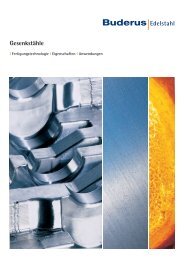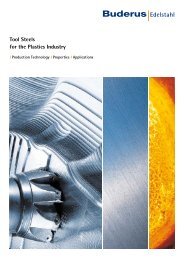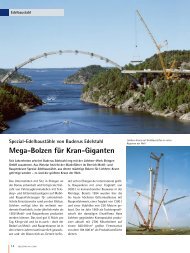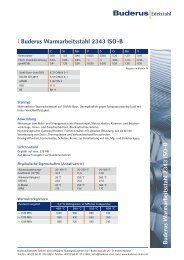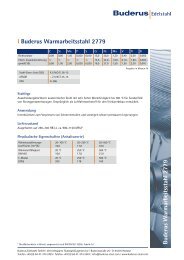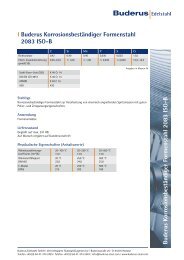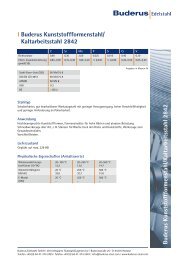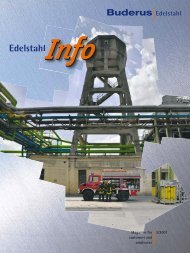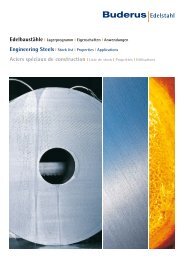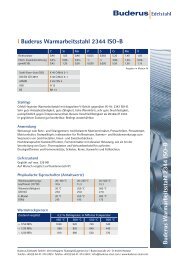Die Steels - Buderus Edelstahl Gmbh
Die Steels - Buderus Edelstahl Gmbh
Die Steels - Buderus Edelstahl Gmbh
You also want an ePaper? Increase the reach of your titles
YUMPU automatically turns print PDFs into web optimized ePapers that Google loves.
<strong>Die</strong> steels can be divided into two groups according to their tempering<br />
behaviour as illustrated in Figure :<br />
Group 1<br />
The low hardness retention of these nickel alloy steels makes<br />
them unsuitable for applications involving high temperature load<br />
(> 500 °C) with relatively long or frequent contact phases, as for<br />
example in presses.<br />
Group 2<br />
These steels are much more resistant to thermal load than those<br />
in Group 1, and also more wear resistant, in line with the higher<br />
carbide content in the matrix. In addition to hardness retention,<br />
the level of the Ac1 conversion temperature is significant for the<br />
temperature capacity of a die steel (cf. Table on page 10). <strong>Steels</strong><br />
with lower Ac1 temperatures can be more easily converted and<br />
hardened after extended press contact phases. The consequences<br />
are premature local wear and cracking in the impression. Measures<br />
to improve wear resistance however generally result in higher<br />
susceptibility to cracking of the forging die.<br />
The tougher nickel alloy steels in group 1 (see table ) are less susceptible<br />
to stress cracking than the higher alloyed steels, containing<br />
special carbides, described in Group .<br />
A low level of thermal conductivity (Table ) can be taken as an<br />
indicator of increasing danger of cracking when exposed to critical<br />
temperature fluctuations.<br />
Figure 3<br />
Comparative hardness profile curve<br />
Hardness (HB)<br />
HB<br />
400<br />
375<br />
350<br />
325<br />
2714 ISO-B<br />
2714 ISO-B mod.<br />
300<br />
0 100 200 300 400 500 600 700 800 900 1000<br />
Rod diameter (mm)<br />
mm<br />
Pre-heating the die to 280 °C<br />
The best known measures for reducing susceptibility to cracking<br />
are increasing material toughness by means of moderate strength<br />
when assembled, and sufficiently high pre-heating temperature<br />
(see Figure 5).<br />
Figure 5<br />
Effect of pre-heating temperature on notch impact energy<br />
Notch impact energy ISO-V (J)<br />
Figure 4<br />
Hardness retention of the Group 1 and Group 2 die steels<br />
Hardness (HRc)<br />
J<br />
100<br />
80<br />
60<br />
40<br />
20<br />
HRc HB<br />
60<br />
55<br />
50<br />
45<br />
40<br />
Group 2 die steels,<br />
hardness 415 HB<br />
0 200 400<br />
Test temperature (°C )<br />
600<br />
Alloy groups<br />
1<br />
2<br />
NiCrMoV<br />
die steels<br />
CrMoV<br />
hot working steels<br />
Pre-heating<br />
temperature for dies<br />
~565<br />
~485<br />
~425<br />
~375<br />
35<br />
~330<br />
0 200<br />
400 600 800<br />
Tempering temperature (°C )<br />
°C<br />
°C<br />
Hardness (HB)<br />
5




